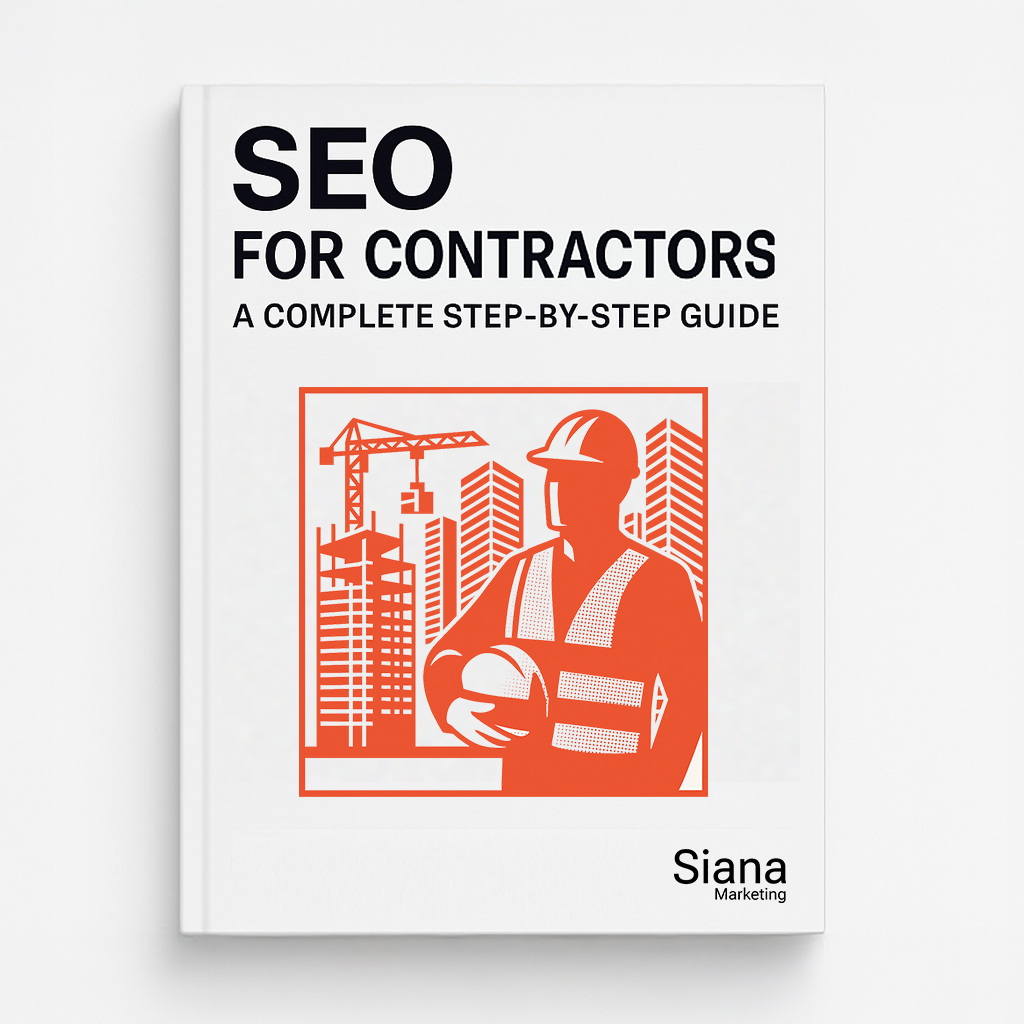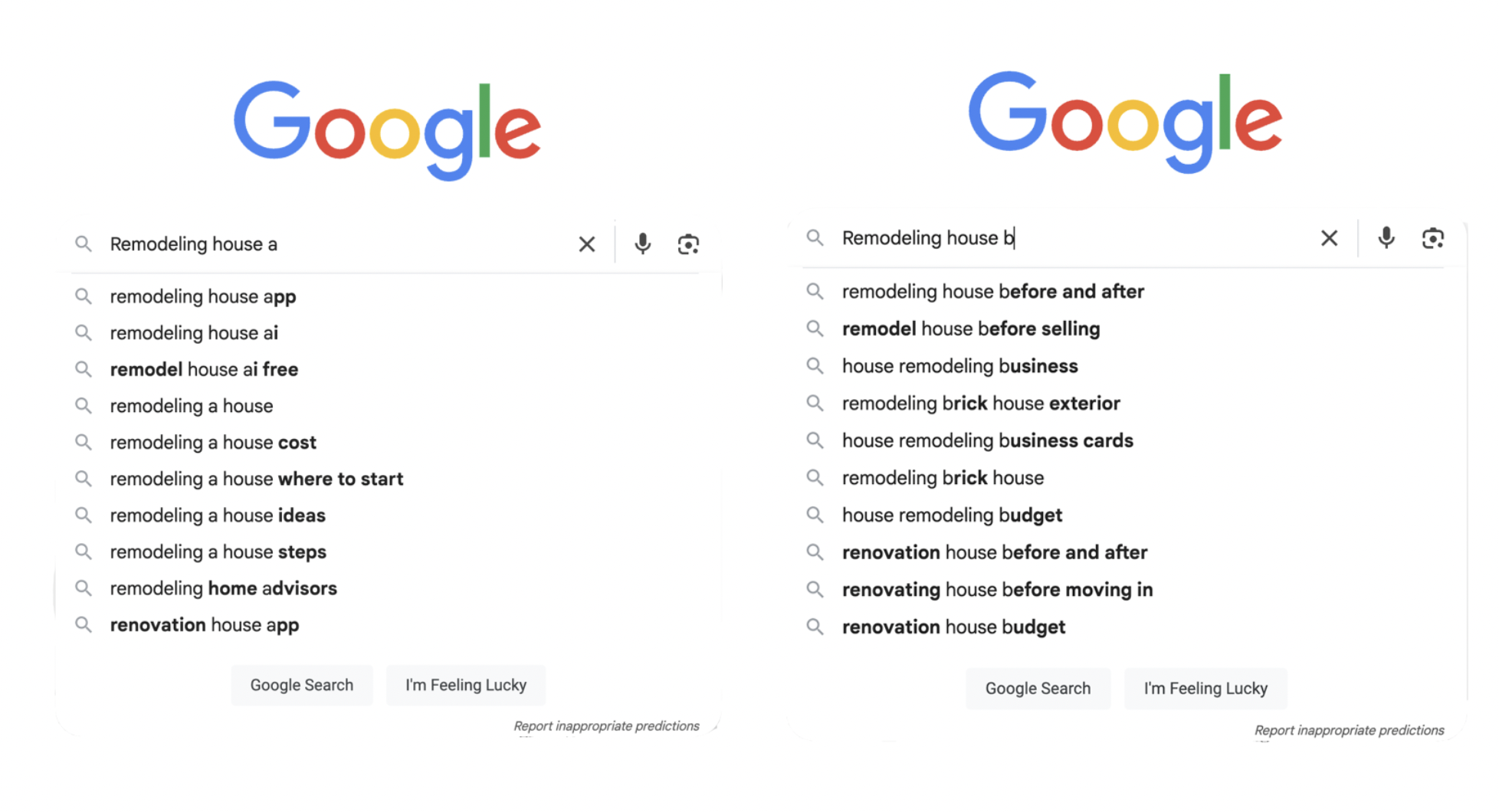SEO for Contractors
A Complete Step-by-Step Guide
If you're a general contractor, remodeler, or niche builder looking to attract more high-quality leads, this SEO guide is for you. Use this checklist to lay a strong foundation, boost your visibility, and grow your business, without depending on ads.
Use the checklist as your action plan. Click any section to jump straight to the content.
The guide is divided into 5 parts, each with clear, actionable steps.
1. Create a Contractor Specific SEO Strategy
Your strategy is like a blueprint or floor plan for a building. It tells you what to do, how to do it, and when.
The “building” you’re constructing is an effective SEO presence that shows Google you’re an expert on a topic, which helps you rank at the top of search results. This brings in a lot of organic traffic, and with it, high-quality leads that are more likely to become clients.
The first steps to defining your strategy are:
Define who your target audience is. Who do you want to speak to?
Define what keywords to target.
Turn keywords into an actionable SEO Plan
Let’s go deeper into these two steps.
Define your Audience
To define your audience, start by asking your team the following questions and documenting the answers:
Who do you want to build for?
What type of construction is your specialty? Is it a specific material, a construction method, a typology, or a geographic region?
What is your expertise? Who have you built for in the past that was successful or enjoyable?
What sets you apart from your competitors? What are you an expert in?
Once you’ve made your list, prioritize it. Focus first on clients you’re most likely to close a project quickly: those whose needs align with your strengths and who operate in markets that aren’t overly competitive.
For example: If you’re a roofing contractor, aiming at all roof repair clients may spread your efforts too thin. By narrowing your focus to commercial flat roof replacements, you’ll connect with a more defined audience that values specialized services.
This is how their table would start look:
| Priority | Client Type | Fit With Our Services | Market Competitiveness |
|---|---|---|---|
| 1 | Homeowners with roof damage | Strong | Low |
| 2 | Property managers of small apartment buildings | Strong | Medium |
| 3 | Real estate agents prepping homes for sale | Moderate | Medium |
| 4 | Commercial building owners | Moderate | High |
| 5 | General contractors on large developments | Weak | High |
Define Which Keywords to Target
With your audience and priorities defined, the next step is choosing which keywords to target. These keywords will guide the content you create, what kinds of blog posts, landing pages, and website copy to include.
Follow this step-by-step process to build a strong keyword strategy:
Step 1: Understand search intent
Before choosing your keywords, it’s essential to understand the searcher’s intent: are they ready to hire, or are they simply gathering information?
The two ends of the keyword spectrum are: transactional and research.
Transactional keywords indicate that a potential client is ready to take action.
Example: “general contractor near me”Research keywords show that the client is still exploring options or looking for advice.
Example: “how to choose a reliable general contractor”
Use the map below to identify where each keyword you brainstorm falls. Prioritize targeting keywords that lean toward the transactional side, as they bring in clients who are closer to making a decision.
Step 2: Define your root keywords
Think like your ideal customer. If you were searching for your own service, what would you type into Google? Start listing those search terms. Focus on phrases that show transactional intent, the ones people use when they’re ready to hire, not just browse.
Example:
If you’re a general contractor in California, some possible root keywords could be:
Remodeling house
Remodeling contractor
Kitchen remodel
Step 3: Create a keyword matrix
Start a spreadsheet or table where each root keyword becomes a header or separate tab. You’ll use this matrix to organize and expand your keyword ideas. A more detailed guide on how to create root pillars (aka. The Hub & Spoke Model) can be found here.
Step 4: Use Google Autofill to expand your list
Once you’ve added your root keywords as titles, use Google Autocomplete to expand them. Start typing each keyword into the search bar and see what suggestions appear, these are real phrases people are actively searching for. Add the most relevant ones to your list.
Follow these steps:
Go to Google.com
Type in a root keyword (e.g. California contractor)
Add a space and type each letter of the alphabet:
Remodeling house a
Remodeling house b
Remodeling house c
…continue through the alphabet
Google will suggest search phrases, review them
Select the transactional and relevant ones for your business
Add those keywords under the corresponding root in your matrix
Following this process, the matrix will start to fill out. At the end of this process, you'll have 10-50 transactional keywords per pillar.
| Remodeling house |
|---|
| Remodeling house steps |
| House remodeling businesses |
| … |
| Renovation contractor |
|---|
| Renovation and construction services |
| Renovation construction companies |
| … |
| Kitchen remodel |
|---|
| Kitchen cabinet contractor |
| Kitchen design contractor |
| … |
Step 5: Fill out each root with at least 8 keywords
Aim to collect a minimum of 10 high-quality keywords per root.
Be strategic. Prioritize keywords that:
Have transactional intent
Are relevant to your services
Are less competitive, so you have a better chance of ranking
For example: if you’re a contractor who builds with prefabrication, the term “prefab construction contractor” might be too competitive. But if you get more specific and prioritize something like “steel frame prefab contractor,” you’ll have a better chance of ranking quickly and attracting a client who is highly interested in that niche.
Turn Your Keywords Into an actionable SEO Plan
Now it’s time to bring the strategy to life.
Step 1: Assign one page per keyword
Each keyword under a root pillar should be turned into its own content page. Depending on the intent of the keyword, choose the format that fits best. E.g.:
Guide blog → For informational or research keywords
Landing page → For transactional or service-based keywords
Case study/project page → To showcase past work and build trust
| Root Pillar: Kitchen Remodel | ||
|---|---|---|
| Keyword | Page Type | Notes |
| Kitchen cabinet contractor | Product Landing Page | Targeted service keyword. Highlight cabinet options, materials, and craftsmanship. Include a CTA. |
| kitchen remodel before and after | Case Study | Showcase transformation. Builds trust and highlights your process and results. |
| kitchen remodel contractor near me | Landing Page | High intent keyword. Focus on location, past projects, client reviews, and a strong CTA. |
| ... | ... | ... |
Treat each root pillar as a mini campaign. Focus on completing all content for one pillar before moving to the next. This keeps your efforts targeted and builds strong topical authority in stages.
Aim to complete one full root pillar every 3–4 months.
Step 2: Build out your 12-month strategy, one pillar at a time
By consistently creating pages for each root pillar, you’ll slowly build a comprehensive SEO ecosystem around your services. Over 12 months, you’ll position your business to rank across multiple relevant search terms, bringing in qualified, organic traffic and real leads.
Example of project timeline:
2. Create High-Quality Content that Ranks and Converts
Once your SEO plan is in place, it’s time to focus on the content itself.
The key is to create content that’s unique, original, and actually answers the searcher’s question. Again, put yourself in the shoes of the person searching that keyword on Google. What are they really looking for? Your job is to give them that information in the clearest, most specific way possible.
That’s why generating content only with AI isn’t enough.
Your content should be:
Precise → Get to the point quickly
Personalized → Write with your specific audience in mind
Appropriately long → Match the depth of the response to the complexity of the question. If the search is simple, answer it simply and clearly
Tip:
Enhance readability with visual elements. Incorporate tables, graphics, and strategic formatting to maintain attention and help readers quickly locate information.
Convert readers into leads with strategic calls-to-action. Include clear CTAs at the bottom of every page and mid-page where appropriate. When direct conversion isn't suitable, use internal links to guide readers to additional content and build trust.
3. Keep Your Content Updated
Your top-performing or most important pages should be reviewed and updated monthly. Secondary pages can be updated every 6 to 12 months.
It doesn’t have to be a big overhaul, just make sure any data, tables, links, or dates stay current.
Tip: Track all updates in a spreadsheet, just like you would manage a construction project. Keep a record of what was changed, when, and by who. Here is an example:
| # | Keyword | Title | Page Type | Last Updated | Link |
|---|---|---|---|---|---|
| 1 | roofing contractor near me | Reliable Roofing Contractor in Your Area | Product Landing Page | July 15, 2025 | https://yourfirm.com/roofing |
| 2 | best roofing companies in [your city] | The Best Roofing Companies in 2025 | Comparison Blog Article | July 28, 2025 | https://yourfirm.com/best-design-build |
| 3 | how much does a new roof cost | 2025 Roof Replacement Cost Guide | Informational Blog Article | April 10, 2025 | https://yourfirm.com/case-studies |
4. Technical SEO: The 30% That Supports the 70%
Technical SEO makes up about 30% of Google’s ranking algorithm, while content accounts for the remaining 70%. That means content is king, but technical SEO still plays a key supporting role.
You want to make sure the technical side of your website is solid, so all the work you're putting into content actually pays off.
Quick Technical SEO Checklist:
Make sure your site checks these basic boxes:
Don’t focus only on the technical side. A perfectly optimized site with weak content still won’t rank. Google prioritizes quality, useful content, technical SEO just makes sure that content can be found, indexed, and trusted.
5. Track Your ROI and KPIs
Once your SEO strategy is live, it’s important to track performance to understand what’s working and measure your return on investment (ROI).
Give it at least 2 months to start showing results, assuming your technical setup is solid.
Pay attention to key metrics like:
How many leads are coming in
How many projects are being generated through organic traffic
How your rankings and site visits are growing over time
That’s how you’ll start to see the true ROI that SEO can deliver.
Stay consistent, and let your SEO strategy compound into long-term, organic growth.
Ready to take the next step? Reach out to explore how we can help you build and scale your SEO strategy.





